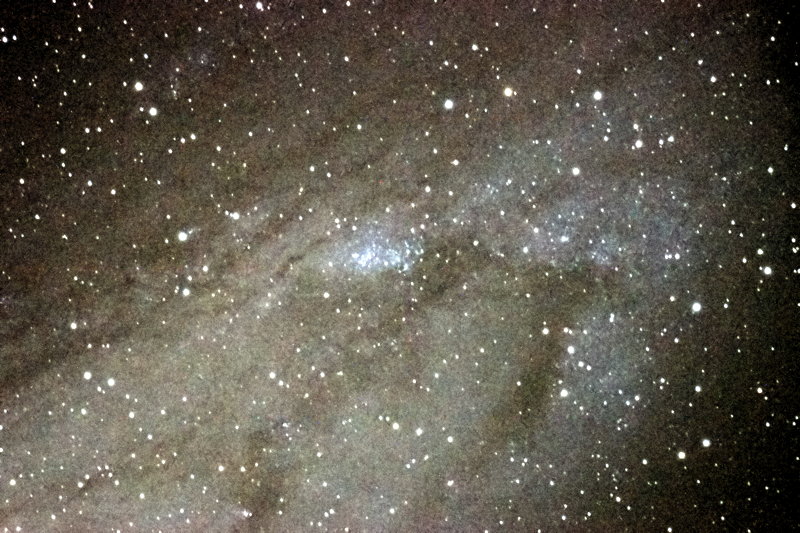
D7000 DSLR: NGC206, G76, C107 in M31 Andromeda Galaxy
Posted: 5 October 2013
Cassiopeia Observatory was opened Friday, 4 October 2013, at 1809 MST, 83°F. The goal for this session was to image some of the objects in the M31 Andromeda Galaxy that I had viewed on the previous session. The sky was clear, although there was a slight breeze blowing when the observatory was opened. Sunset occurred before opening.
At 1814 MST, viewed Mercury in the 8" LX200-ACF, 83X and 222X. Mercury was very low in the sky and seeing was not very good. Mercury seemed to be about half illuminated. Then viewed Venus, 222X. It had a similar phase illumination. Next, viewed Saturn, 222X. Due to its low altitude in the sky, seeing was not good. 1820 MST, Cassini Division was partially visible occasionally. At 1824 MST, reduced the magnification to 83X on Saturn. No moons were yet visible. At 1831 MST, the moon Titan became visible. At 1844 MST, the moon Dione was occasionally glimpsed, but at 1845 MST, Saturn was completely blurred out due to its low altitude.
I left Saturn and slewed the telescope to M31. At 1857 MST, the neighbor to the north turned on their bright, unshielded, horizontally aimed (at the observatory) floodlights. Fortunately, the lights were only on for a few minutes. After the lights went off, I viewed M31 at 83X. I then enabled "High Precision" on the AutoStar and did a GOTO NGC206 (stellar association in M31). NGC206 was placed at the center of the 24mm UWA eyepiece (83X) field-of-view. I then began waiting for astronomical twilight to end. While waiting, I prepared the D7000 DSLR for prime focus imaging. At 1916 MST, as astronomical twilight was ending, NGC206 was visible at 83X. At 1939 MST, G76 (globular cluster) and C107 (open cluster) in M31 were viewed.
I slewed to the star Alpha Andromeda at 2000 MST. It would be the focus test star. I mounted the D7000 DSLR at prime focus using the Off-Axis Guider (OAG). Did the focus test using the Bahtinov Mask. Still using High Precision, slewed the telescope to NGC206 and began looking for a guide star in the OAG illuminated reticle eyepiece. A faint star was located. I then did a short wait for M31 to rise a little higher in the sky. I began imaging at 2030 MST. First was a 1 minute ISO 6400 framing test exposure. That was followed by 2, 5, and 10 minute guided exposuress. During the 10 minute exposure, I kept loosing sight of the faint guide star and so guiding was not accurate. But the 5 minute exposure worked out well:

Mouse over the image or tap on the image (if using a touchscreen device) to show object labels.
I completed imaging at 2055 MST. At 2104 MST, I viewed NGC204, a small faint galaxy, 83X. The last DSO viewed this night was M30 (globular cluster), 83X.
The observatory was closed at 2127 MST, 62°F. I plan to try to image the G1 globular cluster in M31 during the next sesssion. See the November 2013 issue of Sky & Telescope magazine for the excellent article "Exploring Messier 31" to learn more about these objects in M31.
Comments are welcome; use the Comments section below, or you can Email Me. Thanks.
Cassiopeia Observatory Home Page